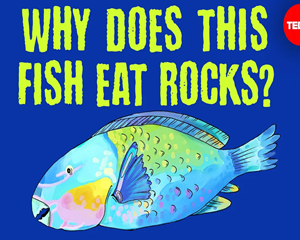As the sun rises over a quiet coral reef, one animal breaks the morning silence.
当晨光轻抚过一簇珊瑚礁之时,一个小动物打破了清晨的安宁。
Named for their vibrant scales and beak-like teeth, these parrotfish are devouring a particularly crunchy breakfast: rocks.
以他们鲜明的鳞片与喙状齿闻名,这群鹦鹉鱼在忙着吃一种特别脆的早餐:石头。
It may not be immediately clear why any creature would take bites out of the seafloor.
也许无法马上明白为什么会有生物想吃海床。
But the diet of these flashy foragers actually plays a key role in defending the coral reef's complex ecosystem.
但是这些亮眼的觅食者其实为保护珊瑚礁复杂的生态系统扮演着重要的角色。
Massive coral reefs begin with tiny coral larvae, which settle on the seafloor's hard surfaces and metamorphasize into coral polyps.
巨大的珊瑚礁始于小小的珊瑚幼虫,它们定居在海床上坚硬的表面上,并变成珊瑚虫。
Over time, these polyps generate rock-like skeletons made of calcium carbonate.
逐渐地,这些珊瑚虫长出形似石头,由碳酸钙组成的骨架。
Together, colonies of polyps produce large three-dimensional structures, which form the basis of an underwater metropolis.
成群的珊瑚虫一起制造出立体的结构,就有了水下都市的基础。
These coral complexes are full of nooks and crannies that house and protect countless life forms.
这些珊瑚构成的结构中处处都是的隐蔽处与缝隙,给无数生命提供了住处和庇护。
Even though coral reefs occupy less than one percent of the ocean floor, these dense ecosystems are home to more than twenty-five percent of marine life.
虽然珊瑚礁仅占据不到1%的海床,有超过25%海洋生物把这些稠密的生态系统当作家。
Many fish use corals as shelters for sleeping and to hide from large predators between their trips foraging for seaweed.
很多鱼把珊瑚当作庇护所,可以在里面睡觉,寻觅海藻期间,也可以借此躲过大型捕食者。
As the primary food source for many of the reef's fish and invertebrates, seaweed is vital to this ecosystem.
海藻是许多礁鱼和无脊椎动物的主要食物,对这个生态系统来说是必不可少的。
But in high densities, seaweed can become problematic, and even lethal to corals.
但如其密度太高,海藻可能会带来害处,甚至会导致珊瑚死亡。
Seaweed grows on the same hard open surfaces that coral larvae rely on, and their growth prevents new coral from settling and expanding.
海藻与珊瑚虫一样,长在坚硬的开放的表面上,所以,它们的生长阻止新的珊瑚定居、扩展。
These competitors have also evolved a variety of ways to kill existing corals, including smothering and abrasion.
这些竞争者也进化出许多杀死珊瑚的方法,包括使其窒息以及磨损。
Some seaweed species even engage in chemical warfare -- synthesizing compounds that destroy coral on contact.
一些海藻物种甚至开始了化学战--生成接触到珊瑚就会使其死掉的化学物质。
This is where parrotfish come in. Like many reef fish, these colorful creatures eat seaweed.
这就是鹦鹉鱼上场的时刻了。和许多礁石鱼一样,这些五彩斑斓的生物吃海藻。
But unlike their neighbors, parrotfish can completely remove even the tiniest scraps of seaweed from the ocean floor.
但它和它邻居不一样的是,鹦鹉鱼能够从海床上完全移除海藻,甚至是其最小的残渣。

Their so-called beak is actually a mosaic of tightly-packed teeth which can scrape and grind rock, allowing them to consume every bit of seaweed covering a stony surface.
它们所谓的喙其实是拼起来的紧凑牙齿,坚硬到能够刮并磨碎石头,这使它们能够把覆盖在石头上的所有海藻都吃光。
This helps parrotfish reach seaweed other fish can't consume, while simultaneously clearing out open space for new corals to settle and existing colonies to expand.
这帮助鹦鹉鱼吃到其他鱼够不到的海藻,还能为新的珊瑚清扫出开放的生长空间,帮助新的珊瑚定居,让原有珊瑚生长。
Eating rocks is just one way parrotfish help manage seaweed.
吃石头只是鹦鹉鱼打理海藻的一种方式。
Through a dynamic system of social networks, parrotfish can convey information to other coral dwelling fish.
通过一个动态社交网,鹦鹉鱼能向其他珊瑚居民传递信息。
Each fish's presence and simple routine behaviors produce sensory information that nearby fish can see, hear, or smell.
每只鱼的存在和它们简单的日常都会生成可以让附近的鱼看、听或闻到的感知信息。
They can even detect changes in water pressure produced by their neighbors using a special sensory organ.
它们甚至能通过一个特别的感知器官察觉到邻居们导致的水压变化。
All these factors can inform the behavior of nearby fish.
所有这些因素,都能传递邻近鱼类的行为信息。
For example, a fish safely entering an open feeding ground and not getting attacked means it's safe to forage.
例如,一条鱼安全地进入到一个开放的觅食区且未受攻击,就意味着在这里觅食是安全的。
Conversely, a fish rapidly leaving a location can provide an early warning that a threat is approaching.
相反的,一条鱼迅速地离开某地就是有危险靠近的预警。
By simply trying to stay alive, these reef fish can incidentally help their neighbors survive -- and more of these fish means less seaweed.
这些礁石鱼仅仅为了努力生存,却无意间也帮助了它们邻居的生存--而越多的鱼就意味着越少的海藻。
Unfortunately, human activities over the last several decades have disrupted almost every part of this complex system.
不幸的是,近几年的人类活动几乎干扰到了这个复杂系统的每一个部分。
In many coral reefs, overfishing has reduced the number of parrotfish, as well as other seaweed eaters, such as surgeonfish and rabbitfish.
很多珊瑚礁中,过度捕捞减少了鹦鹉鱼的数量,以及其他吃海藻的鱼,例如,刺尾鱼和蓝子鱼。
This has led to unchecked seaweed growth, which threatens to degrade entire coral reefs.
这导致了海藻过量生长,威胁到了整个珊瑚礁的生存。
The parrotfish that remain live in much smaller communities.
幸存的鹦鹉鱼只得生活在更小的群落里。
Their reduced numbers can weaken their social network, making surviving fish more timid and less effective at controlling seaweed.
它们下降的数目能动摇它们的社交网,使得存留的鱼越加胆小,难以控制海藻。
Today, climate change and pollution are lowering coral's natural defenses while contributing to runaway seaweed growth -- leaving reef ecosystems more fragile than ever.
在今天,全球暖化和环境污染在降低珊瑚的自然保护,同时使海藻肆意生长--让珊瑚生态系统越加脆弱。
Our reefs are vitally important to both marine and human life.
我们的珊瑚对海洋生命和人类至关重要。
Their unparalleled biodiversity offers unique opportunities for ecotourism, sustainable fishing, and scientific research,
它们无以伦比的生物多样性为生态旅游,可持续捕鱼和科学研究提供了独特的可能性,
while their rocky structures guard coastlines from waves and storm surges.
同时,它们似岩石的构造保护海岸线不受海浪和风暴的侵害。
Fortunately, continued research into reef species like the quirky and critical parrotfish can inform new strategies for preserving these essential ecosystems.
幸运的是,对珊瑚礁物种的持续研究,像是稀奇古怪且至关重要的鹦鹉鱼,可以提供用于保护这些生态系统的新策略。













